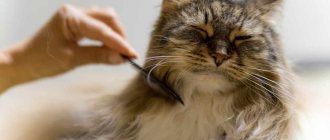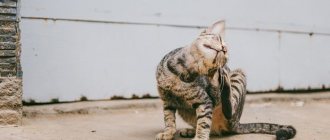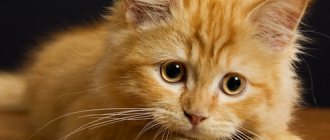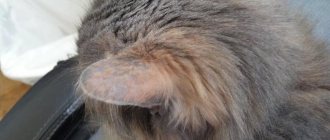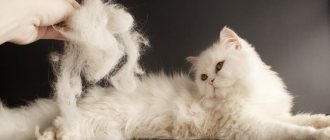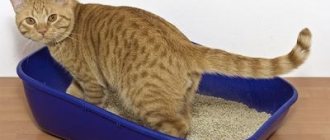12832Administration
4
It's a big decision to get a pet. Thus, we take responsibility for his well-being. But what if we encounter problems, for example, a cat’s fur is falling out in clumps, what should we do and how to help our pet?
What you are now faced with is not much like ordinary shedding, in which everything in the house is covered with an even layer of hair that has fallen from your cat. Now the wool is found in clumps. And you can often observe that this fur has come out along with part of the skin. Another unusual point is that the cat has bald patches here and there. And the skin turned red or scales or sores appeared on it.
© shutterstock
What are we dealing with? What kind of disease is this? Can we help our cat on our own? And should you seek help from a veterinarian?
Why does a cat lose hair: 9 reasons
Among the main reasons causing intense hair loss it is worth noting:
- Seasonal shedding - in the autumn-spring months, cats actively change the density of their fur coat. In indoor individuals, molting takes longer than in outdoor individuals, lasting 2-3 months.
- Pregnancy of a cat with insufficient quality and quantity of nutrition will lead to the appearance of sparse fur. Just before giving birth, the expectant mother plucks the hair around her nipples; this is normal.
- Old age - older animals in most cases step in the thick fur of their younger counterparts.
- Stress is vitality, the resistance of cats to problems is greatly exaggerated. These animals react sensitively to changes in housing, owners, the arrival of strangers in the house, etc. Experiences affect the condition of the fur coat in a negative way.
- Lack of vitamins. With an unbalanced diet, with a constant lack of vitamins and minerals, wool falls out profusely.
- Allergy. The source of problems can be inappropriate food, care products, household chemicals, etc.
- Helminth infestation, fleas, ticks. A large number of parasites poison the body.
- Hereditary disposition.
- Skin diseases: seborrhea, folliculitis, adenitis, etc.
Correct determination of the root cause is the result of a complete, quickest possible elimination of hair loss and restoration of the pet’s health.
How to help your pet
But, unfortunately, there are more serious reasons why cats’ hair can fall out in clumps. By recognizing them, you can influence the situation.
What can cause a cat to lose hair in clumps?:
- Poor nutrition;
- The cat has problems with the digestive system;
- Hormonal disorders;
- Allergic reactions;
- Skin parasites;
- Granuloma;
- Skin diseases;
- Stress.
It is quite difficult to recognize why a cat’s fur is coming out in clumps. Let's take a closer look at each reason to understand what to do and what treatment is needed to stop hair falling out in clumps in your beloved cat.
- Poor nutrition . An unbalanced diet without essential vitamins often causes a kitten’s fur to come out in clumps. A mono-diet can also lead to this, when one product dominates in a cat’s diet.
- The cat has problems with the digestive system . Even when the cat receives all the necessary trace elements, vitamins, fats, proteins and carbons, it is important that the body digests the food. If a cat has problems with the gastrointestinal tract, his fur may begin to fall out in clumps due to vitamin deficiency:
- Hormonal disorders . If the cat's glands do not produce sufficient amounts of hormones, the cat will lose hair in large quantities, in clumps. Excess hormones also disrupt important life cycles.
- Allergic reactions . The allergy itself causes hair loss, but can simultaneously lead to severe itching, due to which the cat will begin to comb and pluck out tufts of its fur.
- Skin parasites . Parasite bites lead to itching, rashes, inflammation and infection of the skin. This is a direct path to the cat’s fur coming out in clumps.
- Granuloma . This is the body's reaction to everything foreign. The disease has different characters and ways of development. But it always leads to the cat losing its fur.
- Skin diseases . Diseases of a fungal nature, skin infections, cancer-related or formations in the form of a cyst, autoimmune and congenital, and a reaction to the sun are observed. All of them lead to the cat's hair falling out in clumps. And even to baldness.
- Stress . Any life changes in a cat can lead to a state of anxiety. He begins to intensively lick himself, and sometimes pluck. Over time, bald spots appear. This can continue until the cat no longer has any cause for stress.
© shutterstock
These and any other reasons that a cat’s fur is coming out in clumps can arise in the life of every cat. They can be temporary, when the treatment has helped and the disease has gone away, or periodic, if the conditions are created, the disease returns and urgent measures need to be taken. Which?
Diseases that cause hair loss in cats
Skin diseases and parasites require proper treatment under the guidance of a veterinarian. Trying to cope with the situation on your own can lead to it becoming chronic. The doctor conducts an initial examination,, if necessary, prescribes tests, scrapings, and then prescribes medications.
The most common diseases leading to severe hair loss:
- Somatic – hyperthyroidism (overactivity of the thyroid gland), hormonal imbalance, adrenal gland disorders, blood pathologies, cancer, an abundance of parasites, hypotrichosis.
- Infectious - fungal infections, dermatitis, adenitis (pathology of the sebaceous glands), seborrhea, lichen, subcutaneous mites.
Be sure to read:
Bald spots in cats: causes of baldness on the back, head, paws and ears
In case of infection, it is necessary to isolate the pet from other pets, limit contact with children, and carefully observe personal hygiene. The patient is treated with special anti-fungal agents, shampoos, and the wounds are taken care of, preventing suppuration and infection. Treating animals with human drugs is strictly prohibited.
Your cat's fur is falling out: what to do?
First of all, it is necessary to analyze the situation, what lifestyle changes could provoke the situation: the food was changed, there was contact with other animals, potential carriers of infections, a child or another pet appeared in the house, which could cause stress, is it time for seasonal molting.
A growing kitten at 5-12 months actively changes its child's fur coat to an adult's one, this is normal. It is important to note the pet’s condition if it maintains its usual activity, is playful, eats well, its eyes and mucous membranes are healthy, clean, and there is no reason to worry.
If, along with the loss of fur, the cat experiences itching, scratches the skin until wounds, refuses to eat, the ears are red, the eyes turn sour, an urgent visit to the veterinary clinic is necessary.
External causes of violation
These factors cause skin irritation and peeling upon direct contact with it. Usually it is enough to eliminate this factor and the skin will return to normal.
Physical factors
Excessive sunlight, high and low temperatures, and insufficient air humidity in the room where the animal is kept can lead to excessive keratinization of the epidermis and active desquamation of the top layer of skin.
Chemical reasons
These are aggressive substances: acids, alkalis and other reagents that have an aggressive effect on the animal’s skin. Such substances can cause not only peeling, but also dermatitis, eczema and atopy.
This group includes not only acids or alkalis, but also shampoos or other skin and hair care products that can irritate the epidermal layer. Quite often, peeling begins as a result of excessive care of the animal’s skin using cosmetics.
Infectious and parasitic factors
This group includes a large number of parasitic infections, which are not so rare. The top three similar causes of the deplorable condition of an animal’s skin are: the consequences of flea dermatitis, lice and demodicosis (infection with small skin mites). In addition to peeling, these pathologies are accompanied by severe itching, loss of animal hair, rashes (bubbles, crusts), and scratching. Parasite eggs and their metabolic products are found in the animal’s fur.
Worm infestations cause skin itching, flaking and deterioration in coat quality. This happens because parasites disrupt the digestive processes, mechanically interfering with the movement of food through the digestive system. And they also absorb nutrients, leading to vitamin deficiencies. The presence of worms in a cat’s body leads to dyspepsia, and sometimes vomiting and diarrhea.
Fungal infections (including ringworm, malassezia) are necessarily accompanied by peeling. Although the first symptom that the owner pays attention to in this case is baldness. The first lesions are usually found on the head and face of the animal. With Malassezia, greasy ears and skin pigmentation are noticeable.
Mechanical factors
Mechanical causes of peeling include abrasions, scratches, and traces of friction. Sometimes the skin peels off at the injection sites. In this case, alopecia areata is usually observed. A crust forms at the site of the injured skin, and the epidermis becomes rough. The skin around the site of injury begins to peel off.
What to do when your pet is shedding
Each hair is “born” from a follicle, which is in a state of activity, forming the structure of the hair. When it grows, a resting phase begins; the hair does not lengthen, but remains in place. After 4-8 months, the hair dies and falls out. The peak of fur coat change occurs in the off-season.
Walking cats become warmer for winter, and before summer their fur coat becomes thinner. Pets can change the order of “changing clothes”: in the summer the air conditioners work in the apartment, and in the winter it becomes hot.
During this period, it is necessary to scratch the cat daily with a comb suitable for the type of fur; this will reduce the amount of hair left by the pet on furniture and carpets. Long-haired breeds (Persians, Maine Coons) develop mats without regular brushing. Cats try to keep themselves tidy and groom themselves.
Fur accumulates in the stomach, which the pet will regurgitate from time to time. To prevent a large accumulation of lumps in the gastrointestinal tract and problems with intestinal obstruction, you can give your pet special food that facilitates the removal of trichobezoars, phytomins, malt paste, or plant grass for cats in a pot.
Be sure to read:
Why does a cat bite and gnaw its tail strongly, sometimes until it bleeds? Should I be worried?
A cat's hair is falling out in clumps to the point of bald patches: what to do?
When shedding, the hair falls out evenly; if bald spots appear, this is an alarming signal, often accompanied by:
- runny nose;
- lacrimation;
- poor appetite;
- loss of body weight with a normal diet;
- peeling of bare skin;
- itching, anxiety, irritability;
- elevated temperature;
- bowel disorders.
In this case, it is necessary to exclude all possible causes of dermatitis: change the diet, choose a different type of tray filler, limit the use of household chemicals and be sure to show the animal to a doctor.
Treatment
Treatment of the disease is directly dependent on the cause of peeling. For vitamin deficiencies, it is enough to introduce fish oil, vegetable oils (linseed, olive), and multivitamins into the animal’s diet.
It is easy to correct the situation when mechanical and physical factors influence the animal’s skin. It is enough to create a favorable microclimate in the room where the animal is kept and prepare soft bedding for it. Treat the skin if your pet gets into a fight.
In case of infectious and parasitic diseases, internal diseases, the underlying disease must be treated. In the case of allergies, first of all, you need to eliminate the influence of the allergen on the cat’s body. This could be low-quality food, shampoos or household chemicals.
Some diseases cannot be cured and can only be maintained in remission with the right diet and medications.
The cat is losing hair in clumps and has sores on the skin: causes and treatment
When a fungal infection occurs, the body becomes covered with small bald spots with round skin flakes. Ringworm is contagious to people; self-medication is strictly prohibited; laboratory tests will determine exactly what treatment will relieve the cat of the disease.
With seborrhea, the skin acquires an unpleasant odor, increased oiliness, and becomes inflamed. A scraping and blood test will help diagnose it. Erythema multiforme appears as a side pathology in oncology and other diseases. Ulcers, depression, watery blisters in the groin, armpits, profuse hair loss are its signs.
Solar dermatosis is more common in white-eared individuals; the skin turns red, peels, and later wounds appear.
Sores in a cat due to hair loss can occur when:
- alopecia areata;
- psychogenic, injection alopecia;
- folliculitis;
- sweat gland cysts.
It is not possible to diagnose the correct cause on your own; in any case, you need to consult a specialist, examine your skin and blood.
Signs of the described deviations
Peeling of the skin is accompanied by the appearance of dandruff throughout the animal's body. Most often, the main areas of damage are the back and the area near the tail. The main signs of peeling skin and hair loss include:
- Excessive thinning or thickening of the animal’s skin;
- Necrosis of a large area of the stratum corneum of the skin caused by pathologies of an internal or external nature;
Almost always, flaking and baldness are accompanied by itching, the presence of which affects the condition of the pet’s skin - it worsens significantly. In addition, the entry of bacteria into scratched wounds leads to the development of inflammatory processes on the skin.
Medicines
Removing parasites is the first step to fluffy, beautiful fur. First, an insecticidal treatment is carried out aimed at exterminating lice, fleas, and ticks. For this purpose, drops, sprays, and shampoos are purchased at the zoological pharmacy. They should be used strictly according to the instructions, without exceeding the concentration, dosage, or procedure time, so as not to poison the pet.
Be sure to read:
Sores on a cat’s neck that itch and hair fall out: normal or pathological, reasons, what to do
The use of dichlorvos and other chemicals not intended for cats is strictly prohibited. If there are a large number of fleas, the treatment is repeated after 7-10 days. Suprastin and diazolin in the dosage recommended by the veterinarian will help relieve itching.
3-7 days after treating the external parasites, a drug is given to remove helminths. The tablet is taken in the morning, along with food, the required dose is calculated according to the cat’s weight. If worms are found in the stool after this, you need to repeat taking the drug after 10-14 days.
Why and when should you go to a veterinary clinic?
If a cat's hair is falling out profusely and in clumps, the first thing the owner should do is seek help from a veterinarian. Hair loss to bald spots can indicate a number of serious diseases.
Even an experienced owner will not always be able to independently determine that his pet is losing hair, because, for example, he has an endocrine disease. Only a veterinarian can do this after reviewing the cat’s hormone tests.
To establish a diagnosis, the cat needs to be examined by a doctor and undergo tests. From the place where the fur grows in clumps, they take a piece of skin for analysis and study the condition of the fur. These tests will show the overall picture of the disease and help develop treatment. Depending on the diagnosis, surgical or drug therapy is prescribed. The pet owner will only need to follow all the veterinarian's instructions.
